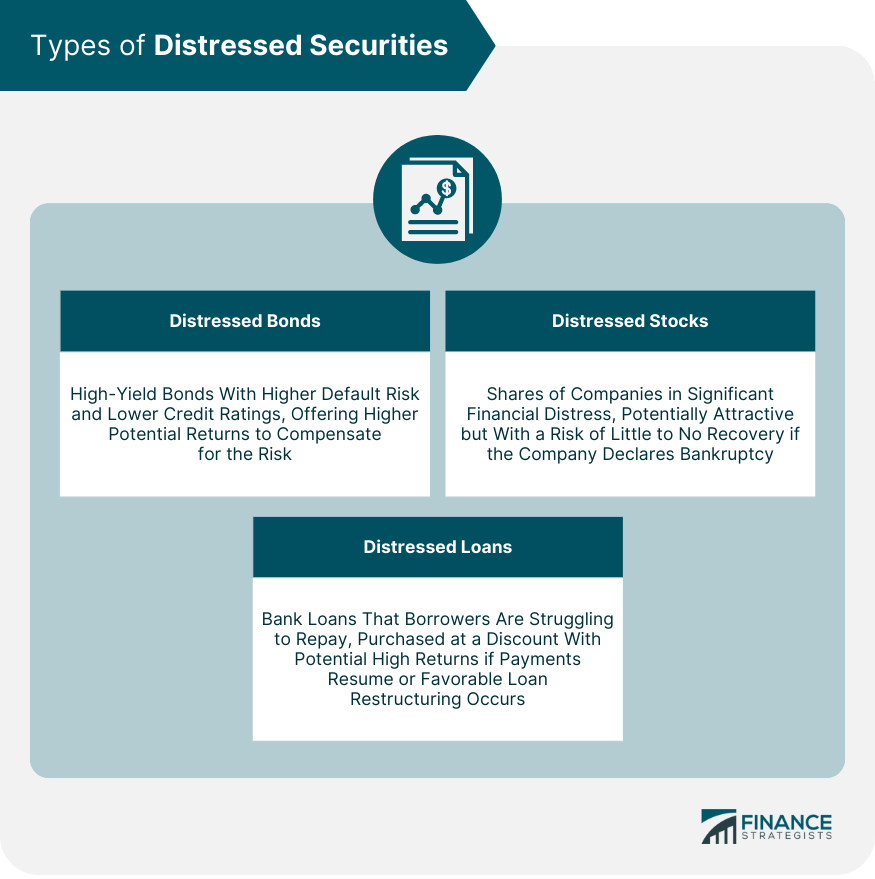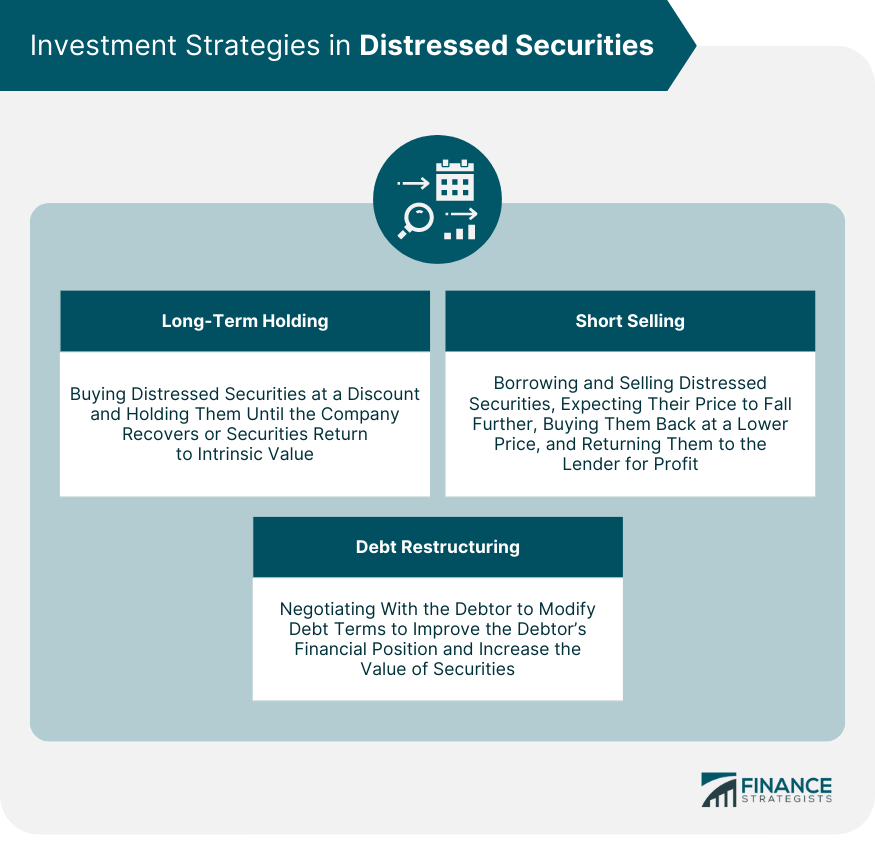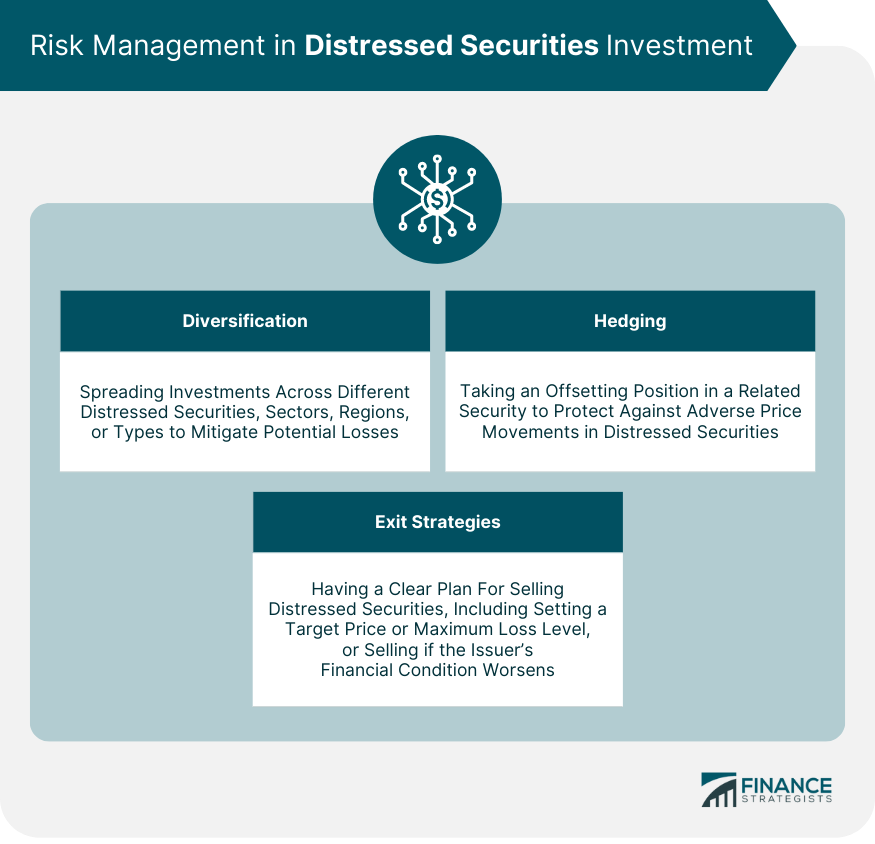Distressed securities are financial instruments issued by a company that is experiencing severe financial difficulties, often to the point of being on the brink of bankruptcy. They typically trade at a significant discount to their intrinsic value because of the high risk associated with them. These securities include bonds, stocks, and loans that are under severe financial pressure. Companies that issue distressed securities are often unable to meet their financial obligations, leading to an increased risk of default. This risk is why distressed securities are considered a type of high-yield or junk bond. The concept of distressed securities dates back to the Great Depression, where investors saw potential in the deeply discounted bonds of struggling companies. However, the practice did not become mainstream until the 1980s, catalyzed by economic downturns and the evolution of bankruptcy laws. The market for distressed securities has since grown exponentially, attracting a diverse set of investors drawn to the potential high returns. Identifying distressed securities is a critical skill for any investor interested in this niche market. Some key financial indicators that suggest a company may be in distress include: 1. High debt levels: A company carrying a substantial amount of debt compared to its assets or revenue might be under financial stress. 2. Declining revenues: If a company's revenues are decreasing over consecutive periods, it may signal financial distress. 3. Cash flow difficulties: A company may be in distress if it's struggling to generate enough cash flow to cover its operational costs and financial obligations. 4. Low-interest coverage ratio: This ratio compares a company's earnings before interest and taxes (EBIT) to its interest expenses. A low ratio suggests the company may struggle to meet its debt obligations. In addition to financial indicators, certain legal signs might signal a company's distress. These can include: 1. Bankruptcy filings: If a company has filed for bankruptcy, its securities automatically become distressed. 2. Legal disputes: Ongoing legal issues, especially if they pose a significant financial threat to the company, can indicate distress. 3. Regulatory issues: Companies in sectors with heavy regulation might face distress if they fail to comply with all necessary rules and standards. It's also vital to consider sector-specific indicators of distress. For example, for a technology company, a lag in research and development could be a warning sign. For a manufacturing firm, outdated equipment may suggest financial trouble. Understanding the nuances of the specific industry can give investors an edge when identifying potential distressed securities opportunities. These typically include hedge funds, private equity firms, and specialized distressed securities funds, all seeking to capitalize on the high-risk, high-reward nature of these investments. However, individual investors with a high tolerance for risk and a deep understanding of financial analysis can also participate in this market. The distressed securities market often mirrors the broader economic climate. During periods of economic expansion, the number of distressed securities typically decreases as companies' financial health improves. Conversely, during economic downturns or recessions, the number of distressed securities can rise significantly, offering more opportunities for investors. The market is also characterized by its illiquidity. Distressed securities are not as easily bought or sold as traditional securities, primarily due to the risk they carry and the specialized knowledge required to invest in them. Various economic factors can impact the distressed securities market. These include interest rates, unemployment levels, and economic policy shifts. For instance, rising interest rates can increase the financial burden on already struggling companies, potentially leading to more distressed securities. Similarly, high unemployment can reduce consumer spending, affecting companies' revenues and potentially pushing them into distress. Distressed bonds, often referred to as high-yield or junk bonds, make up a large portion of distressed securities. These bonds have a higher default risk, reflected in their lower credit ratings. However, they offer higher potential returns to compensate for this risk. Distressed stocks refer to the shares of companies in significant financial distress. These stocks can experience drastic price decreases, making them potentially attractive to risk-tolerant investors. However, if the company declares bankruptcy, equity holders often recover little to nothing, making distressed stocks a risky investment. Distressed loans are another form of distressed securities. These can include bank loans that a borrower is struggling to repay. Distressed loans can be purchased at a significant discount, offering potentially high returns if the borrower can resume payments or if the loan can be restructured favorably. A comprehensive analysis of a company's financial statements is crucial when considering investment in distressed securities. This analysis can provide insights into the company's financial health, its ability to generate profits, and its potential for recovery. Investors should pay close attention to the balance sheet, income statement, and cash flow statement, looking for red flags such as declining revenue, increasing debt, or negative cash flow. Comparing the distressed company to its industry peers can provide valuable context. This benchmarking process might reveal whether the company's distress is due to company-specific issues or broader industry trends. For instance, if most companies in the industry are struggling, it may be more challenging for the distressed company to recover. Credit analysis can provide further insight into the distressed company's financial health. It involves assessing the company's credit history, its current credit ratings, and the likelihood of default. Poor credit ratings from agencies like Moody's, Standard & Poor's, or Fitch can be an indicator of financial distress. However, experienced distressed securities investors often go beyond these ratings, conducting their own in-depth credit analysis to assess default risk. Understanding bankruptcy law is essential for any distressed securities investor. When a company files for bankruptcy, it triggers a legal process that prioritizes the claims of different creditors. Typically, senior debt holders are paid first, followed by subordinate debt holders, with equity holders last in line. In many cases, equity holders receive nothing if a company goes bankrupt, which contributes to the high risk of distressed equity investments. Bankruptcy law can also provide opportunities for restructuring the company's debts, which could lead to a recovery in the value of its securities. However, the outcomes of bankruptcy processes are highly uncertain, adding another layer of risk to distressed securities investments. Mergers and acquisitions (M&A) can play a significant role in the distressed securities market. A distressed company may become a takeover target for a healthier company, providing a potential exit strategy for distressed securities investors. Nonetheless, M&A transactions in distressed situations can be complicated and require careful analysis and due diligence. The rights of debtors and creditors are another important legal aspect of distressed securities. These rights can influence the recovery prospects for different types of securities in the event of a bankruptcy. For instance, secured creditors generally have a stronger claim on the company's assets than unsecured creditors. Understanding debtor and creditor rights requires a thorough knowledge of bankruptcy law and, often, consultation with legal experts. These rights can significantly affect the risk-reward profile of a distressed securities investment. One approach to investing in distressed securities is a long-term holding strategy. This strategy involves buying the securities at a discount and holding them until the company recovers or the securities return to their intrinsic value. However, this strategy requires patience and a high tolerance for risk, as the recovery process can take several years and may not occur at all. Short selling is another strategy that can be used with distressed securities. This involves borrowing the securities and selling them, with the expectation that their price will fall further. If the price does fall, the investor can buy the securities back at a lower price, return them to the lender, and pocket the difference. This strategy can be profitable in a declining market but comes with substantial risks if the market moves in the opposite direction. Investors can also profit from distressed securities through debt restructuring. This involves negotiating with the debtor to modify the terms of the debt, such as reducing the principal or interest rate, or extending the maturity date. If successful, restructuring can improve the debtor's financial position and increase the value of its securities. Diversification is a fundamental principle of investing that is especially relevant in the context of distressed securities. Because these securities carry a high risk of default, spreading investments across different securities can help mitigate potential losses. Diversification can involve investing in distressed securities from different sectors, geographical regions, or even different types of distressed securities. Hedging involves taking an offsetting position in a related security to protect against adverse price movements in the distressed security. For example, an investor might short sell a stock index while investing in distressed stocks, as a general decline in the stock market could increase the likelihood of recovery for the distressed companies. Given the high-risk nature of distressed securities, having a clear exit strategy is critical. This could involve setting a target price at which to sell the security or a maximum loss level at which to cut losses and move on. Additionally, an exit strategy might involve selling the distressed security if the issuer's financial condition worsens beyond a certain point. Investing in distressed securities can have significant impacts on various stakeholders, including employees, customers, and the broader community. Job losses, for example, can result from a company's financial distress or bankruptcy. Investors should consider these impacts when deciding whether to invest in distressed securities. From a sustainability and social responsibility perspective, investing in distressed securities presents complex considerations. On one hand, investing in a distressed company might provide it with the financial lifeline it needs to survive and preserve jobs. On the other hand, by enabling a struggling company to continue operating, investors might inadvertently perpetuate harmful practices, such as poor environmental performance. This is a critical ethical consideration for distressed securities investors. It includes complying with securities laws and regulations, such as disclosure requirements, as well as with bankruptcy laws if the issuer files for bankruptcy. Distressed securities are financial instruments, such as stocks, bonds, or loans, that belong to companies facing financial difficulties or undergoing some form of distress. These are often traded at significantly discounted prices due to the uncertain financial position of the issuing company. Investing in distressed securities requires a comprehensive understanding of financial analysis, legal aspects, and risk management. The market presents opportunities for high returns, but it is complex and niche, attracting investors willing to navigate the high-risk, high-reward nature of these investments. By carefully evaluating financial indicators, considering legal factors, and understanding industry-specific nuances, investors can identify potential opportunities in distressed securities while effectively managing risks. Ethical considerations, such as the impact on stakeholders and compliance with regulations, should also be taken into account when making investment decisions in this market. Successful investment in distressed securities relies on thorough analysis of a company's financial health, comparison to industry peers, and credit assessment. Implementing diversification strategies, hedging against adverse price movements, and having clear exit strategies are crucial for risk management. Balancing financial considerations with ethical implications is important to make responsible investment choices.What Are Distressed Securities?
Identifying Distressed Securities
Financial Indicators of Distress
Legal Indicators of Distress
Sector-Specific Indicators
Distressed Securities Market
Participants
Market Dynamics
Impact of Economic Factors
Types of Distressed Securities
Distressed Bonds
Distressed Stocks
Distressed Loans

Financial Analysis of Distressed Securities
Company's Financial Statements
Industry Comparison and Benchmarking
Credit Analysis
Legal Aspects of Distressed Securities
Bankruptcy Law
Mergers and Acquisitions
Debtor and Creditor Rights
Investment Strategies in Distressed Securities
Long-Term Holding
Short Selling
Debt Restructuring

Risk Management in Distressed Securities Investment
Diversification
Hedging
Exit Strategies

Ethical Considerations in Distressed Securities Investment
Impact on Stakeholders
Sustainability and Social Responsibility
Regulatory Compliance
Final Thoughts
Distressed Securities FAQs
Distressed securities are financial instruments issued by companies in significant financial distress. They typically trade at a significant discount due to the high risk associated with them.
Distressed securities can include bonds, stocks, and loans. Distressed bonds and loans may offer the prospect of higher returns if the issuer can recover, but they also carry a high risk of default. Distressed stocks can also provide substantial returns if the company recovers but are particularly risky as equity holders often receive nothing if the company goes bankrupt.
You can identify distressed securities by looking at a company's financial indicators, such as high debt levels, declining revenues, and cash flow difficulties. Legal indicators, such as bankruptcy filings, can also signal distress. Additionally, understanding the specific industry can help identify sector-specific distress indicators.
Investing in distressed securities carries a high risk. These risks include the potential for the issuer to default or declare bankruptcy, which can lead to substantial losses. Other risks include market illiquidity and the uncertainty of the legal processes involved in distressed situations.
You can manage the risks of investing in distressed securities through diversification, hedging, and having a clear exit strategy. Additionally, thorough financial and credit analysis can help assess the issuer's financial health and the likelihood of recovery.
True Tamplin is a published author, public speaker, CEO of UpDigital, and founder of Finance Strategists.
True is a Certified Educator in Personal Finance (CEPF®), author of The Handy Financial Ratios Guide, a member of the Society for Advancing Business Editing and Writing, contributes to his financial education site, Finance Strategists, and has spoken to various financial communities such as the CFA Institute, as well as university students like his Alma mater, Biola University, where he received a bachelor of science in business and data analytics.
To learn more about True, visit his personal website or view his author profiles on Amazon, Nasdaq and Forbes.











